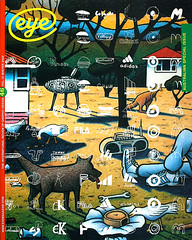Winter 2002
Instant content
Design is Kinky is a graphic design website that's high on content, low on critical awareness. It's a hit! Critique by Rick Poynor
Design is Kinky is one of those instantly intriguing project names that, once heard, is impossible to forget. In the four years since he launched it, Andrew Johnstone’s website has established itself as a notable fixture in the Internet design landscape. Johnstone, a designer based in Sydney, now claims to receive as many as 11,000 visitors a day, about fifteen per cent of them from Australia, the rest from overseas.
He started DiK (www.designiskinky.com) because, at the time, there didn’t seem to be much around like it and he wanted to get involved in the Internet and have fun learning how to communicate with it. ‘I love the internationalism of the Web,’ he says in an interview on the site, ‘and also the ease of being able to publish your own work and have the world check it out in a matter of minutes.’ DiK has been through five versions to date and its latest incarnation, built on a collection of white text boxes in a plain grey frame, would seem to be the simplest, certainly in terms of being easy to update. Johnstone and his helpers do this on a rolling basis, as new material arises, rather than according to a regular timetable or programme. This is not a site where you lose your bearings trying to navigate a needlessly tricksy structure. It places the emphasis firmly on the content.
DiK’s core has always been a series of interviews with designers, some 45 of them to date, mainly conducted through email by Johnstone. Mixed in with established names known for print work or graffiti – Designers Republic, Büro Destruct, Shepard Fairey, Banksy – are leading lights of Web design such as Toke Nygaard, Mike Cina and Amy Franceschini of Futurefarmers, as well as fellow Australian designers such as Rinzen and Justin Fox of Australianinfront.com.au, a local site focused on the Australian design scene. Johnstone’s style of questioning is easy-going rather than probing and each chat ends with an endearingly guileless ‘Thanks Toke!’ or ‘Thanks Banksy!’
Johnstone presents this material to the reader more or less as he receives it, with minimal editing, leaving frequent misspellings and wonky grammar uncorrected. Nor does he see himself as being engaged in a journalistic form of activity. ‘I don’t know,’ he replied, when I asked him about this, during a meeting in Sydney. ‘I’ve never really thought about that, to be honest. I wouldn’t necessarily categorise it like that.’ The site would gain in authority, impact and precision of communication if he paid the same attention to the craft of text production and presentation that he naturally pays, as a designer, to the craft of design. The idea that it’s somehow more ‘authentic’ to leave in distracting mistakes is naïve at best. It’s possible, of course, that many of DiK’s readers don’t notice these errors and don’t much care, even if they do spot them. Where the lack of editing shows most clearly is in one of the most ambitious areas of the site – its ‘Theory’ section. With three participants contributing to each topic – the most recent is ‘design and mainstream culture’ – this promises more than it delivers. It isn’t a discussion, which would require careful mediation and editing, so much as a trio of distinct and often very block-like texts plonked down rather unappetisingly one after the other.
At this point in its life, DiK is perhaps poised between two kinds of activity. The friendly, non-critical tone and regular features such as a gallery of personal mugshots sent in by site visitors suggest something sociable, inward-looking, cliquey and not especially serious. But the site’s intention to act as a forum and participate in a global design discussion also implies wider responsibilities and, if it’s to be convincing, a commitment to higher standards of thinking and presentation.
Every so often there are signs of frustration, too. ‘I feel that a lot of the older generation Australian designers . . . are actively destroying our international design abilities,’ says Justin Fox in a DiK interview. ‘We seem ashamed of our design work and this is so wrong.’ In April 2003, DiK will present its first design conference in Sydney, titled ‘Semi-Permanent’, with contributions from many of the designers featured on the site. If the aim is to sharpen perceptions of young Australian design and encourage real debate – and not simply to provide yet another occasion for self-referential ‘celebration’ – then a more critically aware approach is essential.
Rick Poynor, writer, founder of Eye, London
First published in Eye no. 46 vol. 12 2002
Eye is the world’s most beautiful and collectable graphic design journal, published quarterly for professional designers, students and anyone interested in critical, informed writing about graphic design and visual culture. It is available from all good design bookshops and online at the Eye shop, where you can buy subscriptions and single issues.

